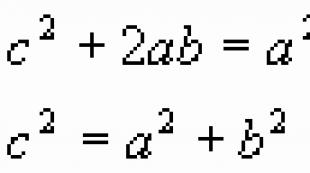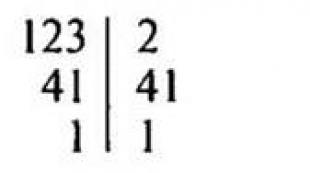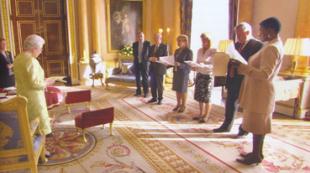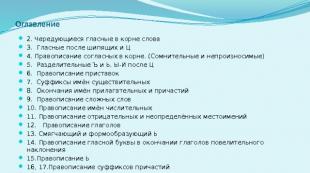The greatest common divisor is coprime. Problems on the topic Greatest Common Divisor. Coprime numbers. The concept of pairwise prime numbers
Goals: to form the skill of finding the greatest common divisor; introduce the concept of relatively prime numbers; to develop the ability to solve problems on the use of GCD numbers; learn to analyze, draw conclusions.
II. Verbal counting
1. Can the prime factorization of 24753 contain a factor of 5? Why? (No, because this number does not end with a 0 or 5.)
2. Name a number that is divisible by all numbers without a remainder. (Zero.)
3. The sum of two integers is odd. Is their product even or odd? (If the sum of two numbers is odd, then one number is even, the second is odd. Since one of the factors is an even number, therefore, it is divisible by 2, then the product is also divisible by 2. Then the whole product is even.)
4. In one family, each of the three brothers has a sister. How many children are in the family? (4 children: three boys and one sister.)
III . Individual work
Expand the number 210 in every possible way:
a) by 2 multipliers; (210 = 21 10 = 14 15 = 7 30 = 70 3 = 6 35 = 42 5 = 105 2.)
b) by 3 multipliers; (210 = 3 7 10 = 5 3 14 = 7 5 6 = 35 2 3 = 21 2 5 = 7 2 15.)
c) by 4 multipliers. (210 = 3 7 2 5.)
IV. Lesson topic message
"Numbers rule the world." These words belong to the ancient Greek mathematician Pythagoras, who lived in the 5th century. BC.
Today we will get acquainted with another group of numbers, which are called coprime.
V. Learning new material
1. Preparatory work.
No. 146 p. 25 (on the board and in notebooks). (On their own, at this time one student works on the back of the board.)
Find all divisors of each number.
Underline their common divisors.
Write down the greatest common divisor.
Answer:
What numbers have only one common divisor? (35 and 88.)
2. Work on a new theme.
(On their own, at this time one student works on the back of the board.)
Find the greatest common divisor of numbers: 7 and 21; 25 and 9; 8 and 12; 5 and 3; 15 and 40; 7 and 8.
Answer:
GCD (7; 21) = 7; GCD (25; 9) = 1; GCD (8; 12) = 4;
GCD (5; 3)= 1; GCD (15; 40) = 5; GCD (7; 8) = 1.
What pairs of numbers have the same common divisor? (25 and 9; 5 and 3; 7 and 8 is a common divisor of 1.)
Such numbers are called relatively prime.
Define relatively prime numbers.
Give examples of relatively prime numbers. (35 and 88, 3 and 7; 12 and 35; 16 and 9.)
VI. Historical moment
The ancient Greeks came up with a wonderful way to find the greatest common divisor of two natural numbers without factoring. It was called "Euclid's Algorithm".
About the life of the Greek mathematician Euclid, reliable data are unknown. He owns an outstanding scientific work called "Beginnings". It consists of 13 books and lays out the foundations of all ancient Greek mathematics.
It is here that Euclid's algorithm is described, which lies in the fact that the greatest common divisor of two natural numbers is the last one, which is different from zero, the remainder when these numbers are successively divided. By successive division is meant the division of a larger number by a smaller one, a smaller number by the first remainder, the first remainder by the second remainder, etc., until the division ends without a remainder. Suppose we need to find GCD (455; 312), then
455: 312 = 1 (rest. 143), we get 455 = 312 1 + 143.
312: 143 = 2 (rest. 26), 312 = 143 2 + 26,
143: 26 = 5 (rest 13), 143 = 26 5 + 13,
26: 13 = 2 (remaining 0), 26 = 13 2.
The last divisor or the last non-zero remainder is 13 and will be the required gcd (455; 312) = 13.
VII. Physical education minute
VIII. Working on a task
1. No. 152, p. 26 (with detailed commentary at the blackboard and in notebooks).
Read the task.
What is the task about?
What is the task about?
Name the 1st question of the task.
How to find out how many children were on the Christmas tree? (Find the GCD of numbers 123 and 82.)
Read the assignment for this task from the notebooks. (The number of oranges and apples must be divisible by the same largest number.)
How to find out how many oranges were in each gift? (Divide the entire number of oranges by the number of children present at the tree.)
How to find out how many apples were in each gift? (Divide the entire number of apples by the number of children present at the tree.)
Write down the solution of the problem in notebooks on a printed basis.
Decision:

GCD (123; 82) \u003d 41, which means 41 people.
123:41 = 3 (ap.)
82:41 = 2 (apple)
(Answer: 41 guys, 3 oranges, 2 apples.)
2. No. 164 (2) p. 27 (after a brief analysis, one student is on the back of the board, the rest on their own, then self-examination).
Read the task.
What is the degree measure of a straightened angle?
If one angle is 4 times smaller, then what about the second angle? (He's 4 times bigger.)
Write it down in a short note.
How will you solve the problem? (Algebraic.)
Decision:
1) Let x be the degree measure of the angle SOK,
4x - degree measure of an angle COD.
Since the sum of the angles SOC and COD equals 180°, then we write the equation:
x + 4x = 180
5x = 180
x=180:5
x = 36; 36° - degree measure of the SOC angle.
2) 36 4 \u003d 144 ° - degree measure of the angle COD.
(Answer: 36°, 144°.)
Build those corners.
Determine the type of angles SOK and COD . (Angle SOK - acute, angle KOD - dumb.)
Why?
IX. Consolidation of the studied material
1. No. 149 p. 26 (at the board with a detailed commentary).
What needs to be done to determine if the numbers are coprime? (Find their greatest common divisor, if it is equal to 1, then the numbers are coprime.)
2. No. 150 p. 26 (oral).
Validate your answer. (9 and 14; 14 and 15; 14 and 27 are pairs of relatively prime numbers, since their gcd is 1.)
3. No. 151 p. 26 (one student at the blackboard, the rest in notebooks).
(Answer:  .)
.)
Who disagrees?
4. Orally, with a detailed explanation.
How to find the greatest common divisor of several natural numbers? (Find in the same way as two numbers.)
Find the greatest common divisor of numbers:
a) 18, 14 and 6; b) 26, 15 and 9; c) 12, 24, 48; d) 30, 50, 70.
Decision:
a) 1. Check if the numbers 18 and 14 are divisible by 6. No.
2. We factorize the smallest number 6 = 2 3 into prime factors.
3. Check if the numbers 18 and 14 are divisible by 3. No.
4. Check if the numbers 18 and 14 are divisible by 2. Yes. Therefore, gcd (18; 14; 6) = 2.
b) GCD (26; 15; 9) = 1.
What can be said about these numbers? (They are relatively prime.)
c) GCD (12; 24; 48) = 12.
d) GCD (30; 50; 70) = 10.
X. Independent work
Mutual verification. (Answers are written on the closing board.)
Option I. No. 161 (a, b) p. 27, No. 157 (b - 1 and 3 numbers) p. 27.
Option II . No. 161 (c, d) p. 27, No. 157 (b - 2nd and 3rd number) p. 27.
XI. Summing up the lesson
What numbers are called coprime?
How can you find out if the given numbers are coprime?
How to find the greatest common divisor of several natural numbers?
Homework
No. 169 (6), 170 (c, d), 171, 174 p. 28.
Additional task:When you rearrange the digits of the prime number 311, you again get a prime number (check this on the table of prime numbers). Find all two-digit numbers that have the same property. (113, 131; 13, 31; 17, 71; 37, 73; 79, 97.)
urban district of Tolyatti
“Greatest common divisor. Coprime numbers.
Teacher Kostina T.K.
g. o. Tolyatti
Presentation on theme: "Greatest Common Divisor.
Coprime Numbers"
Preliminary preparation for the lesson: students should know the following topics: "Divisors and multiples", "Signs of divisibility by 10, 5, 2, 3, 9", "Prime and composite numbers", "Decomposition into prime factors"
Lesson Objectives:
Educational: to study the concepts of GCD and relatively prime numbers; teach students to find GCD numbers; create conditions for developing the ability to summarize the studied material, analyze, compare and draw conclusions.
Educational: the formation of self-control skills; fostering a sense of responsibility.
Developing: development of memory, imagination, thinking, attention, ingenuity.
During the classes
Minutes of logical tasksOral work.
1. Grandparents brought an odd number of apricots from the garden for their two grandchildren. Can these apricots be divided equally among the grandchildren? [can]
2. From one village to another 3 km. Two people came out of these villages towards each other with the same speed. The meeting took place half an hour later. Find the speed of each.
3. The tourist has passed 2/5 of the whole way. After that, he had to go 4 km more than he did. Find all the way.
4. The number of eggs in the basket is less than 40. If they are counted in pairs, then 1 egg will remain. If you count them in triplets, then there will still be one egg each. How many eggs are in the basket? (31)
2. Repetition.
According to the table, we repeat the definition of a divisor, a multiple, signs of divisibility, the definition of prime and composite numbers. On the screen are slides depicting animals, a map of the Samara region, photographs of a VAZ.
3. Learning new material in the form of a conversation.
What are the divisors of the number 18, 21, 24.
The area of the VAZ is 500 hectares. Into what prime factors can this number be decomposed? 500=2*5*2*5*5=2 2 *5 3
What are the common divisors of the numbers 120 and 80.
The weight of the bear is 525 kg. The mass of an elephant is 5025 kg. Name some common divisors
The beaver weighs 24 kg and is 97 cm long. Which numbers are simple or complex? Name their common divisors.
56640 tons of oxygen is consumed by 1 passenger aircraft for 9 hours of operation. This amount of oxygen is released during photosynthesis of 35,000 hectares of forest. Name some divisors of this number.
Which of these numbers are prime and which are composite? 111, 313, 323, 437, 549, 677, 781, 891?
Which number is divisible by all numbers without a remainder?
What is the divisor of any natural number?
Is the expression 34*28+85*20 divisible by 17?
Is the expression 4132*7008 divisible by 3?
What is the quotient (3*5*2*7*13)/(5*2*13)=?
What is the product of (2*5*5*5*3)*(2*2*2*2*3)?
Name some prime numbers.
The further we go along the natural series of numbers, the more difficult it is to find prime numbers. Imagine that we are flying in an airplane that flies along a natural line. It's dark all around and only prime numbers are marked with lights. There are a lot of lights at the beginning of the journey, and then less and less.
The ancient Greek scientist Euclid proved 2300 years ago that there are infinitely many prime numbers and that there is no largest prime number.
The problem of prime numbers was studied by many mathematicians, including the ancient Greek scientist Eratosthenes. His method of finding prime numbers was called the sieve of Eratosthenes.
Goldbach and Euler, who lived in the 18th century and were members of the St. Petersburg Academy of Sciences, dealt with the problem of prime numbers. They assumed that every natural number can be represented as a sum of prime numbers, but this has not been proven. In 1937, the Soviet academician Vinogradov proved this proposition.
An Indian elephant lived for 65 years, a crocodile for 51 years, a camel for 23 years, and a horse for 19 years. Which of these numbers are prime and composite?
The wolf is chasing the hare, he needs to get through the labyrinth. You can pass if the answer is a prime number [mazes in the form of circles, on which there are three examples, and in the center there is a house]
1000-2; 250*2+9; 310/5
24/4, 2 2 +41, 23+140
10-3; 133+12; 28*5
To the task on the board record:
Divisors 48: 1, 2, 3, 4, 6, 8, 12, 16, 48
Divisors 36: 1, 2, 3, 4, 6, 12, 18, 36
GCD (48; 36) \u003d 12 12 gifts determination of the GCD of the divisor rule for finding the GCD
And how to find the GCD of large numbers, when it is difficult to list all the divisors. According to the table and the textbook, we derive the rule. We highlight the main words: decompose, compose, multiply.
I show examples of finding GCD from large numbers, here we can say that GCD of large numbers can be found using the Euclidean algorithm. We will get acquainted with this algorithm in detail in the classroom of the mathematical school.
An algorithm is a rule according to which actions are performed. In the 9th century, such rules were given by the Arab mathematician Alkhvaruimi.
4. Work in groups of 4 people.
Everyone gets one of 4 options for tasks, where the following is indicated:
The student must study the theory from the textbook and answer one question
Study an example of finding GCD
Complete tasks for independent work.
At the end of the work, a small independent work is carried out.
CSR cards
Option 1
1. What number is called prime? What is a composite number?
2. Find GCD (96; 36)
To find the GCD of numbers, you need to decompose the given numbers into prime factors.
| 96 | 2 |
| 48 | 2 |
| 24 | 2 |
| 12 | 2 |
| 6 | 2 |
| 3 | 3 |
| 1 |
| 36 | 2 |
| 18 | 2 |
| 9 | 3 |
| 3 | 3 |
| 1 | |
36=2 2 *3 2
96=2 5 *3
The expansion of the number that is the GCD of the numbers 96 and 36 will include the common prime factors with the smallest exponent:
GCD (96;36)=2 2 *3=4*3=12
3. Decide for yourself. GCD(102; 84), GCD(75; 28), GCD(120; 144)
Option 2
1. What does it mean to decompose a natural number into prime factors? What is the common divisor of these numbers?
2. Sample GCD (54; 72)=18
3. Solve yourself GCD(144; 128), GCD(81; 64), GCD(360; 840)
Option 3
1. What numbers are called relatively prime? Give an example.
2. Sample GCD (72; 96) =24
3. Solve yourself GCD(102; 170), GCD(45; 64), GCD(864; 192)
Option 4
1. How to find a common divisor of numbers?
2. Sample GCD (360; 432)
3. Solve yourself GCD (135; 105), GCD (128; 75), GCD (360; 8400)
Independent work
| Option 1 | Option 2 | Option 3 | Option 4 |
| NOD (180; 120) | NOD (150; 375) | NOD (135; 315; 450) | NOD (250; 125; 375) |
| NOD (2016; 1320) | NOD (504; 756) | NOD (1575, 6615) | NOD (468; 702) |
| NOD (3120; 900) | NOD (1028; 1152) | NOD (1512; 1008) | NOD (3375; 2250) |
5. Summing up the lesson. Reporting grades for independent work.
Solving problems from the problem book Vilenkin, Zhokhov, Chesnokov, Schwarzburd for grade 6 in mathematics on the topic:
§ 1. Divisibility of numbers:
6. Greatest common divisor. Coprime numbers
146 Find all the common divisors of the numbers 18 and 60; 72, 96 and 120; 35 and 88.
DECISION
147 Find the prime factorization of the greatest common divisor of a and b if a = 2 2 3 3 and b = 2 3 3 5; a = 5 5 7 7 7 and b = 3 5 7 7.
DECISION
148 Find the greatest common divisor of the numbers 12 and 18; 50 and 175; 675 and 825; 7920 and 594; 324, 111 and 432; 320, 640 and 960.
DECISION
149 Are the numbers 35 and 40 coprime; 77 and 20; 10, 30, 41; 231 and 280?
DECISION
150 Are the numbers 35 and 40 coprime; 77 and 20; 10, 30, 41; 231 and 280?
DECISION
151 Write down all proper fractions with a denominator of 12 whose numerator and denominator are relatively prime numbers.
DECISION
152 The guys received the same gifts on the New Year tree. All gifts together contained 123 oranges and 82 apples. How many children were present at the Christmas tree? How many oranges and how many apples were in each gift?
DECISION
153 For a trip outside the city, several buses were allocated to the plant's employees, with the same number of seats. 424 people went to the forest, and 477 went to the lake. All seats on the buses were occupied, and not a single person was left without a seat. How many buses were allocated and how many passengers were on each of them?
DECISION
154 Calculate verbally in a column
DECISION
155 Using Figure 7, determine if the numbers a, b, and c are prime.
DECISION
156 Is there a cube whose edge is expressed by a natural number and whose sum of the lengths of all edges is expressed by a prime number; surface area expressed as a prime number?
DECISION
157 Factorize the numbers 875; 2376; 5625; 2025; 3969; 13125.
DECISION
158 Why, if one number can be decomposed into two prime factors, and the second - into three, then these numbers are not equal?
DECISION
159 Is it possible to find four distinct prime numbers such that the product of two of them is equal to the product of the other two?
DECISION
160 In how many ways can 9 passengers be accommodated in a nine-seater minibus? In how many ways can they accommodate themselves if one of them, who knows the route well, sits next to the driver?
DECISION
161 Find the values of expressions (3 8 5-11):(8 11); (2 2 3 5 7):(2 3 7); (2 3 7 1 3):(3 7); (3 5 11 17 23):(3 11 17).
DECISION
162 Compare 3/7 and 5/7; 11/13 and 8/13;1 2/3 and 5/3; 2 2/7 and 3 1/5.
DECISION
163 Use a protractor to plot AOB=35° and DEF=140°.
DECISION
164 1) Beam OM divided the developed angle AOB into two: AOM and MOB. The AOM angle is 3 times the MOB. What are the angles AOM and BOM. Build them. 2) Beam OK divided the developed angle COD into two: SOK and KOD. The SOC angle is 4 times less than KOD. What are the angles COK and KOD? Build them.
DECISION
165 1) Workers repaired an 820 m long road in three days. On Tuesday they repaired 2/5 of this road, and on Wednesday 2/3 of the rest. How many meters of the road did the workers repair on Thursday? 2) The farm contains cows, sheep and goats, a total of 3400 animals. Sheep and goats together make up 9/17 of all animals, and goats make up 2/9 of the total number of sheep and goats. How many cows, sheep and goats are on the farm?
DECISION
166 Express as a common fraction the numbers 0.3; 0.13; 0.2 and as a decimal fraction 3/8; 4 1/2; 3 7/25
DECISION
167 Perform the action, writing each number as a decimal fraction 1/2 + 2/5; 1 1/4 + 2 3/25
DECISION
168 Express as the sum of prime terms the numbers 10, 36, 54, 15, 27 and 49 so that there are as few terms as possible. What suggestions can you make about representing numbers as a sum of prime terms?
DECISION
169 Find the greatest common divisor of a and b if a = 3 3 5 5 5 7, b = 3 5 5 11; a = 2 2 2 3 5 7, b = 3 11 13 .
DZ check
How is the preparation for
offset -02.10
and KR - 29.09.
on the topic "Divisibility of numbers" M.6, §1.pp.5-34, mini-abstracts on pp. 33-34 on the topic:
"Pythagoras", "Sieve of Eratosthenes"
What natural number is called a divisor of a natural number a?
Prove that 4 is a divisor of 24.
Prove that 3 is not a divisor of 25.
List all natural divisors of 12.
What is the divisor of any natural number?
What natural number is called a multiple of a natural number a?
How many multiples does any natural number have?
What is the smallest multiple of a natural number?
Which numbers are divisible by 10 and which are not divisible by 10? Give examples.
Which numbers are divisible by 5 without a remainder, and which are not divisible by 5 without a remainder? Give examples.
Which numbers are called even and which numbers are called odd?
Prove that 8 is even and 15 is odd.
Name even numbers.
Name the odd numbers.
What digit should the number end with in order for it to be even (divided without a remainder by 2), and with which digit should the number end so that it
was odd? Give examples.
Which number is divisible by 9 and which number is not divisible by 9?
Which number is divisible by 3 and which number is not divisible by 3?
What natural number is called prime?
What natural number is called composite?
Which number is neither prime nor composite?
How many and into what factors can any composite number be decomposed?
Name the first 10 prime numbers.
Write down the factorization of the number 210.
Can every composite number be factored into prime factors?
Is the following notation a prime factorization: 2 3 4 5?
What natural number is called the greatest common divisor of natural numbers a and b?
What two numbers are called coprime? Give examples.
To find the greatest common divisor of several natural numbers, you need ....
Find GCD(16;42)
What natural number is called the least common multiple of the natural numbers a and b?
To find the least common multiple of several natural numbers, you need to ....
Find LCM(6;15)
Show by example that a b \u003d GCD (a; c) LCM (a; c)
Test No. 1 - September 29 Sample text of the CG
Option 1.
Option 2.
1. Factor the number 5544 into prime factors.
1. Factor the number 6552 into prime factors.
2.Find the greatest common divisor and
Least common multiple of 504 and 756.
Least common multiple of 1512 and 1008.
3. Prove that the numbers:
3. Prove that the numbers are:
a) 255 and 238 are not coprime;
a) 266 and 285 are not coprime;
b) 392 and 675 are coprime.
b) 301 and 585 are coprime.
4. Follow the steps: 268.8: 0.56 + 6.44 12.
4. Follow the steps: 355.1: 0.67 + 0.83 15.
5. Can the difference of two prime numbers be
5. Can the sum of two prime numbers be
prime number? (Give an example). Page 28,
№
164(1)
DZ check Page 27. No. 164(1).
BUT
AOW 180
M
3x
X
DZ check
IN AOB AOM MOV
O
x+3x=180
4x=180
x=180:4
x=45
PTO 45, AOM 3 45 135
Answer: 135°, 45° DZ check
Page 28,
b)
№
169(b).
a=2 2 2 3 5 7, c=3 11 13
GCD(a,b)=3
10.
Page 28, 170(c,d)DZ check
c) GCD(60,80,48)=2 2=4
60
30
15
5
1
2
2
3
5
80
40
20
10
5
1
2
2
2
2
5
48
24
12
6
3
1
2
2
2
2
3
11.
DZ checkPage 28, 170(c,d)
d) GCD(195,156,260)=
195 3
65 5
13 13
1
156
78
39
13
1
2
2
3
13
13
260
130
65
13
1
2
2
5
13
12.
DZ checkPage 28, 171
gcd(861,875)=1
864
432
216
108
54
27
9
3
1
2
2
2
2
2
3
3
3
875
175
35
7
1
5
5
5
7
The numbers 861 and 875 are coprime
13.
Page 28,№
Turners -
3 people
Locksmiths
2x
174
DZ check
people
-x pers.
3x+2x+x=840
6x=840
x=840:6
x=140
milling machines
Millers-140,
Locksmiths-280,
Turners -420.
Answer: 420 people.
What could be
not find?
14. Evaluate the PD: - all answers are correct and the solution is written in detail "5" - all answers are correct and the solution is written in detail, but allowed
computational errors"4"
- the answers are correct, but the solution is either
incomplete or non-existent
"3"
- no homework - "2"
15. 09/25/2017 Classwork Greatest common divisor. Coprime numbers.
16. Lesson objectives:
- Summarize knowledge about the greatestcommon divisor and coprime
numbers.
- Develop the ability to work
on one's own.
- Learn to listen
others.
- Continue shaping
culture of oral and written
mathematical speech.
17.
Work individually. Restorally and in a notebook
Individual work on
cards
18.
Verbal counting1. Can decomposition into simple
multipliers of 14652
contain a multiplier
3?
Why?
2. Name all odd numbers,
satisfying the inequality
234<х<243
19.
Verbal counting3.
Name 3 multiples of:
a) 5; b) 15; c) number
a
4. Name 2 numbers, mutually
prime with number:
a) 3,
b) 7,
at 10 o'clock,
d) 24
20.
Work in a notebook:Find the greatest common
divisor of the numerator and
denominator of fractions:
20
8
30 , 24 ,
15
35 ,
gcd(20,30)=
8
24
13
26 , 9 , 60 .
21.
Work in a notebook:Find the greatest common
divisor of the numerator and
denominator of fractions:
20
8
30 , 24 ,
15
35 ,
gcd(20,30)=10
gcd(8,24)=
8
24
13
26 , 9 , 60 .
22.
Work in a notebook:Find the greatest common
divisor of the numerator and
denominator of fractions:
20
8
30 , 24 ,
15
35 ,
gcd(20,30)=10
gcd(8,24)=8
gcd(15,35)=
8
24
13
26 , 9 , 60 .
23.
Work in a notebook:Find the greatest common
divisor of the numerator and
denominator of fractions:
20
8
30 , 24 ,
15
35 ,
gcd(20,30)=10
gcd(8,24)=8
gcd(15,35)=5
gcd(13,26)=
8
24
13
26 , 9 , 60 .
24.
Work in a notebook:Find the greatest common
divisor of the numerator and
denominator of fractions:
20
8
30 , 24 ,
15
35 ,
gcd(20,30)=10
gcd(8,24)=8
gcd(15,35)=5
gcd(13,26)=13
gcd(8,9)=
8
24
13
26 , 9 , 60 .
25.
Work in a notebook:Find the greatest common
divisor of the numerator and
denominator of fractions:
20
8
30 , 24 ,
15
35 ,
gcd(20,30)=10
gcd(8,24)=8
gcd(15,35)=5
gcd(13,26)=13
gcd(8,9)=1
gcd(24,60)=
8
24
13
26 , 9 , 60 .
26.
Work in a notebook:Find the greatest common
divisor of the numerator and
denominator of fractions:
20
8
30 , 24 ,
15
35 ,
gcd(20,30)=10
gcd(8,24)=8
gcd(15,35)=5
gcd(13,26)=13
gcd(8,9)=1
gcd(24,60)=12
8
24
13
26 , 9 , 60 .
27.
Physical education minute28.
We solve the problemPage 26, #153
Read the task.
What is the task about?
What is the task about?
29.
We solve the problemPage 26, #153
Can we answer immediately
1 question:
How many buses were there?
30.
We solve the problemPage 26, #153
How to find how much
passengers on each bus?
Sections: Mathematics , Competition "Presentation for the lesson"
Class: 6
Presentation for the lesson



 Back forward
Back forward
Attention! The slide preview is for informational purposes only and may not represent the full extent of the presentation. If you are interested in this work, please download the full version.
This work is intended to accompany the explanation of a new topic. The teacher selects practical and homework assignments at his discretion.
Equipment: computer, projector, screen.
Progress of explanation
Slide 1. Greatest common divisor.
oral work.
1. Calculate:
a) 0,7
* 10
: 2
- 0,3
: 0,4
_________
?b) 5
: 10
* 0,2
+ 2
: 0,7
_______
?
Answers: a) 8; b) 3.
2. Refute the statement: The number “2” is the common divisor of all numbers.”
Obviously, odd numbers are not divisible by 2.
3. What are numbers that are multiples of 2 called?
4. Name a number that is a divisor of any number.
In writing.
1. Factor the number 2376 into prime factors.
2. Find all common divisors of 18 and 60.
Divisors of the number 18: 1; 2; 3; 6; nine; eighteen.
Divisors of 60: 1; 2; 3; 4; 5; 6; ten; 12; fifteen; 20; thirty; 60.
What is the greatest common divisor of 18 and 60.
Try to formulate what number is called the greatest common divisor of two natural numbers
Rule. The largest natural number that can be divided without a remainder is called the greatest common divisor.
They write: GCD (18; 60) = 6.
Please tell me, is the considered method of finding the GCD convenient?
The numbers may be too large and it is difficult for them to list all the divisors.
Let's try to find another way to find GCD.
Let's decompose the numbers 18 and 60 into prime factors:
18 = ![]()
Give examples of divisors of the number 18.
Numbers: 1; 2; 3; 6; nine; eighteen.
Give examples of divisors of the number 60.
Numbers: 1; 2; 3; 4; 5; 6; ten; 12; fifteen; 20; thirty; 60.
Give examples of common divisors of 18 and 60.
Numbers: 1; 2; 3; 6.
How can you find the greatest common divisor of 18 and 60?
Algorithm.
1. Decompose these numbers into prime factors.
![]()









